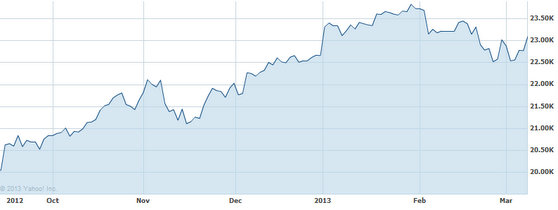Main reference: Story in Sinafinance
HONG KONG'S benchmark Hang Seng Index could hit the 50,000 point level by 2015, said Morgan Stanley.
That would be more than a doubling of the current 22,234 level.
Performances like Wednesday’s 1% mini spike in the Index would certainly be a nice start to the over 27,000 points still needed in order to reach the US investment bank’s lofty 2015 prediction.
 Sink or Swim: Hong Kong's all-important property developers could make or break any potential Hang Seng bull run. Photo: CentalineThe house went on to say that this year could see the Hang Seng hit 32,000 points under its most bullish scenario – up some 44% from current levels.
Sink or Swim: Hong Kong's all-important property developers could make or break any potential Hang Seng bull run. Photo: CentalineThe house went on to say that this year could see the Hang Seng hit 32,000 points under its most bullish scenario – up some 44% from current levels.
It may be hard for many existing Hong Kong shareholders to fully buy into this bullishness as shares have lost around 400 points since the beginning of the year after putting forth a standout second half in 2012.
But despite equities in the Special Administrative Region struggling to regain traction for much of 2013 so far, Morgan Stanley posited four reasons why it believes the Hang Seng is set for a two-plus-year extended upswing, or 120% over recent levels.
Firstly, it said a very loose monetary policy by major industrialized countries continues to buoy both external demand for Hong Kong transshipments as well as boosting asset prices in the city – notably the all-important property sector.
Indeed, despite macroeconomic measures such as China’s “marriage fees” for newlywed homebuyers and Hong Kong’s “non-resident levies” on foreign speculators looking to play the city’s property market – real estate prices in the SAR continue to edge upwards.
While not necessarily good for first-time home shoppers, it does create a stable upside for listed developers, which make up a sizeable percentage of the Hang Seng Index and can thus make or break a bull run on their own merits.
Furthermore, Hong Kong’s most important market – Mainland China – is likely to achieve its healthy and sustainable GDP target of 7.5% this year, thus keeping consumption of goods and services from Hong Kong-listed enterprises on an upward trajectory for the most part.
 Hong Kong shares have struggled to regain traction of late
Hong Kong shares have struggled to regain traction of late
Secondly, history has shown that the Hang Seng Index is a strong believer in “Lucky Seven.”
Looking back on post-War Hong Kong, every six to eight years on average the benchmark Index has surged to a new high, including the years 1973 (pre-oil shock), 1981 (recession), 1987 (pre-Wall Street selloff), 1994, 2000 (pre-dot.com bust), and 2007 (pre-Wall Street crash).
Forecasting 50,000 points by end-2015 would not be out of character with the rates of increase seen in the above-mentioned watershed end-bull run years, and would be around 58% higher than the 2007 pinnacle.
Thirdly, the current average P/E ratio is a tantalizingly affordable 11 times.
If this litmus test of value climbs back to historical levels, then a 50,000-point Hang Seng Index is within reach by 2015.
Finally, QDII expansion is putting pressure on Hong Kong authorities to help divert money away from private property investments in the crowded metropolis and balance out the flow of foreign monies into PRC stocks by boosting purchases of Hong Kong-listed shares.
Add to this the fact that in its latest market strategy report on Greater China, the US firm has begun recommending investors reduce holdings in China’s big-four state-owned commercial banks.
That could help encourage a diversion of financial sector investment from A-shares to H-shares.
See also:
Young Investor Makes Killing In Hong Kong
 Sink or Swim: Hong Kong's all-important property developers could make or break any potential Hang Seng bull run. Photo: CentalineThe house went on to say that this year could see the Hang Seng hit 32,000 points under its most bullish scenario – up some 44% from current levels.
Sink or Swim: Hong Kong's all-important property developers could make or break any potential Hang Seng bull run. Photo: CentalineThe house went on to say that this year could see the Hang Seng hit 32,000 points under its most bullish scenario – up some 44% from current levels. Hong Kong shares have struggled to regain traction of late
Hong Kong shares have struggled to regain traction of late NextInsight
a hub for serious investors
NextInsight
a hub for serious investors






